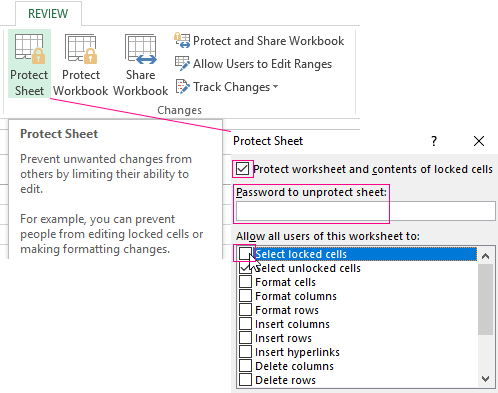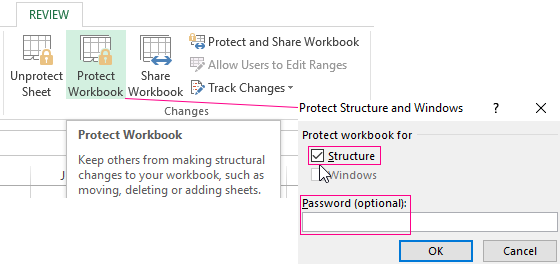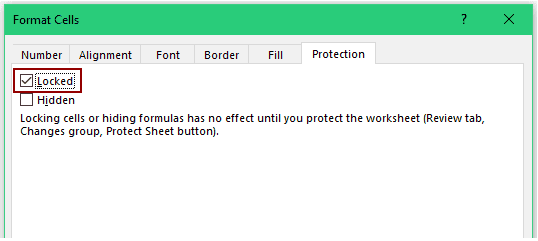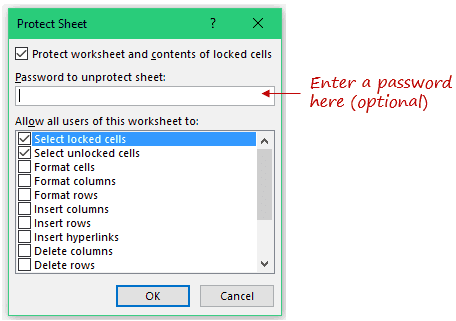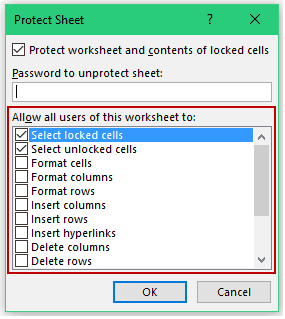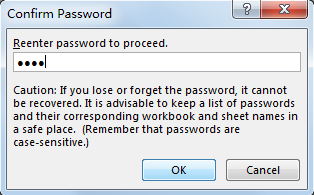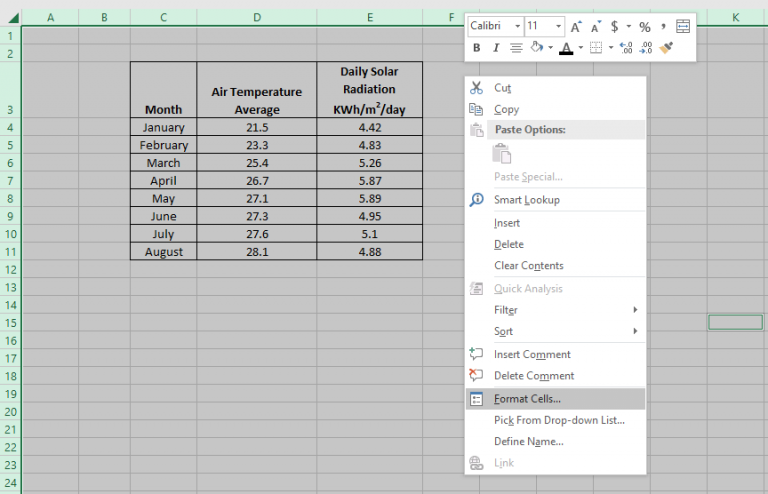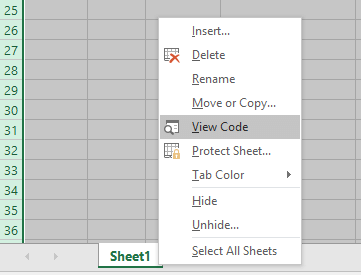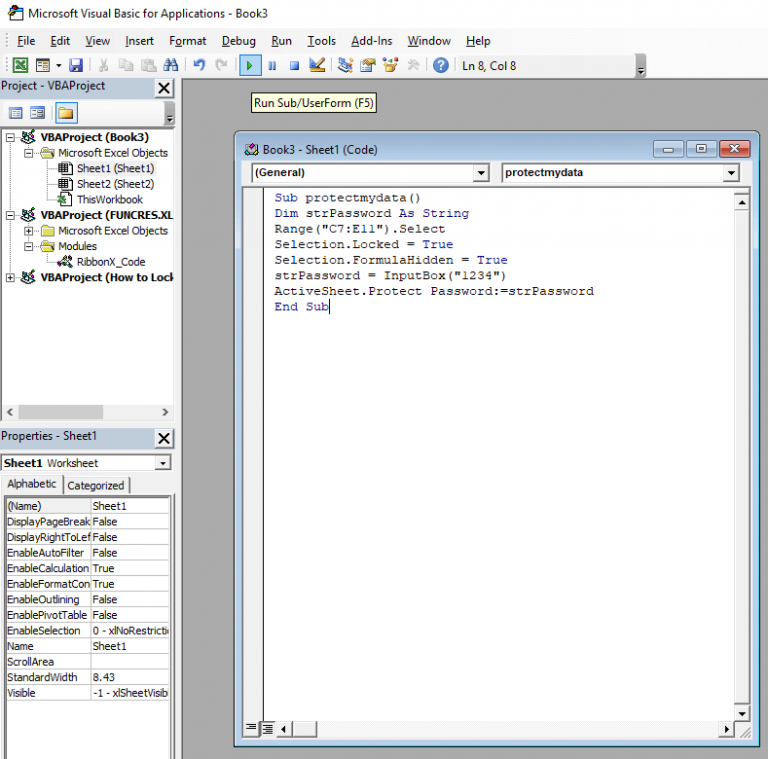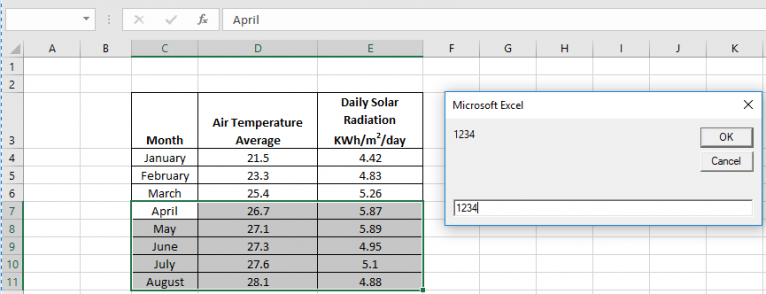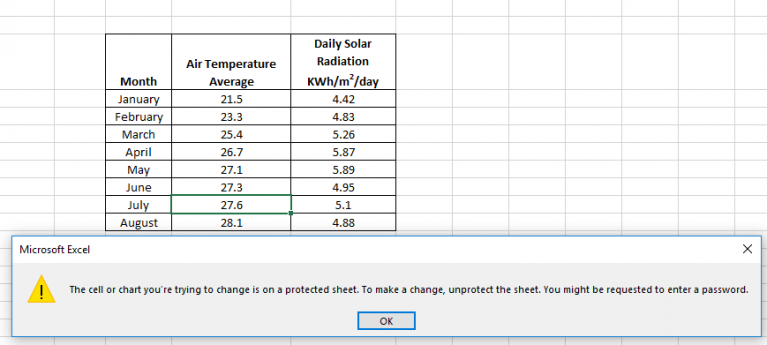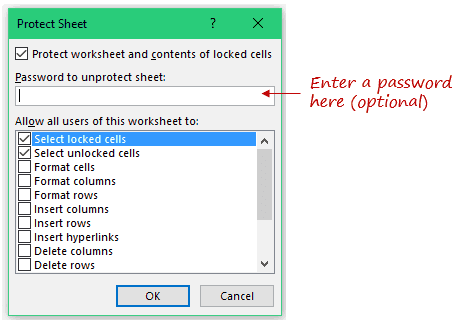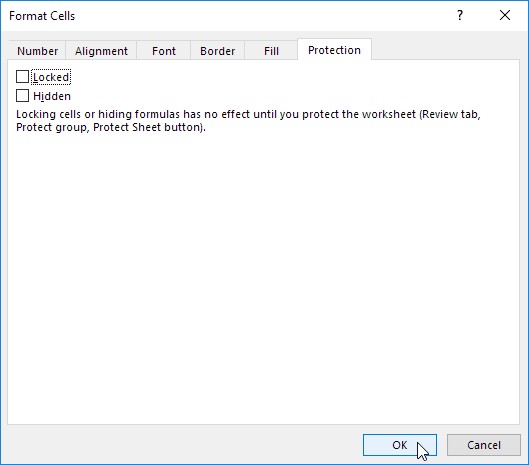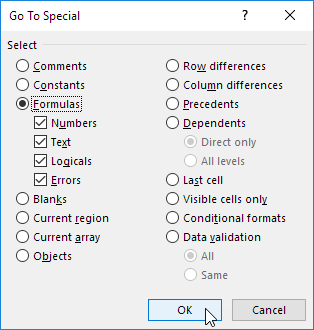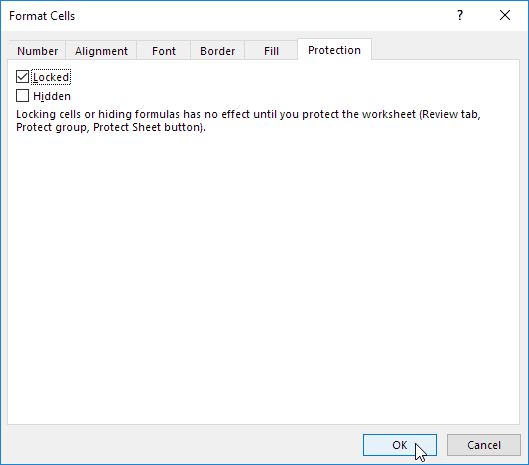Suppose that your boss wants you to protect an entire workbook, but also wants to be able to change a few cells after you enable protection on the workbook. Before you enabled password protection, you had unlocked some cells in the workbook. Now that your boss is done with the workbook, you can lock these cells.
Follow these steps to lock cells in a worksheet:
-
Select the cells you want to lock.
-
On the Home tab, in the Alignment group, click the small arrow to open the Format Cells popup window.
-
On the Protection tab, select the Locked check box, and then click OK to close the popup.
Note: If you try these steps on a workbook or worksheet you haven’t protected, you’ll see the cells are already locked. This means that the cells are ready to be locked when you protect the workbook or worksheet.
-
On the Review tab in the ribbon, in the Changes group, select either Protect Sheet or Protect Workbook, and then reapply protection. See Protect a worksheet or Protect a workbook.
Tip: It’s a best practice to unlock any cells that you may want to change before you protect a worksheet or a workbook, but you can also unlock them after you apply protection. To remove protection, simply remove the password.
In addition to protecting workbooks and worksheets, you can also protect formulas.
Excel for the web can’t lock cells or specific areas of a worksheet.
If you want to lock cells or protect specific areas, click Open in Excel and lock cells to protect them or lock or unlock specific areas of a protected worksheet.
Data in Excel can be protected from extraneous interference. This is important, because sometimes you spend a lot of time and effort creating a pivot table or a large array, and another person accidentally or intentionally changes or completely deletes all your work.
Let’s consider the ways of protecting an Excel document and its single elements.
Protection of Excel cells from changing
How to put protection on a cell in Excel? By default, all cells in Excel are protected (locked). It’s easy to check: right-click on any cell, select «Format Cells» – «Protection». We can see that the check box on the «Locked» item is selected. But this does not mean that they are protected from changes.
Why do we need this information? The thing is that Excel doesn’t provide the function allowing you to protect a single cell. We can enable protection of the worksheet, and then all the cells on it will be protected from editing and other interference. On the one hand, it is convenient, but what if we don’t need to protect all the cells, but only some of them?
Let’s consider an example. We have a simple spreadsheet with data. We need to send this spreadsheet to branch stores, so that the stores could fill in the «SOLD QUANTITY» column and send it back. To avoid making any changes to other cells, let’s protect them.
First, remove protection from those cells to which employees of branch stores will make changes. Select C3: D7, right-click to open the menu, select «Format Cells» and remove the check box from «Locked».
Now select «REVIEW» – «Changes» — «Protect Sheet» tab. A window appears with 2 check boxes selected. Clear the first one, to exclude any interference of branch stores’ employees, except for filling «SOLD QUANTITY» column. Come up with a password and click OK.
Warning! Do not forget your password!
Now other people can only enter some value in C3: D7 range. Since we have limited all other actions, no one can even change the background color. All the formatting tools on the top toolbar aren’t active, that is, they do not work.
Protection of an Excel workbook from editing
If several people work on one computer, it is advisable to protect their documents from editing by third parties. It is possible to put protection not only on separate worksheets, but also on the whole workbook.
When the workbook is protected, outsiders can open the document, see the written data, but they cannot rename the sheets, insert a new one, change their location, etc. Let’s have a try.
Save the previous formatting. That is, you still can make changes only in «SOLD QUANTITY» column. To protect the workbook completely, select «REVIEW» – «Changes» — «Protect Workbook» tab. Click the check box opposite «Structure» item and come up with a password.
Now, if we try to rename the worksheet, we will not succeed. All commands are gray-colored: they don’t work.
The protection from the worksheet and the workbook is removed with the same buttons. When removing, the system will require the same password.
Home > Microsoft Excel > How to Protect Cells in Excel Workbooks —5 Easy Ways
This Protect Excel Workbook tutorial is suitable for users of Excel 2010/2013/2016/2019 and Microsoft 365.
Objective
Protect Excel Workbook, Worksheets, and protect cells in Excel to help maintain the integrity of the spreadsheet and reduce errors.
This guide covers:
Table Of Contents
- Objective
- Video Tutorial – Protect Cells in Excel
- How to protect cells in Excel Explained
- Protect cells in Excel – The Best Methods
- Protect Excel Workbook by Encrypting with a Password
- Protect Excel Workbook with Open as Read-Only feature
- Protect Excel Workbook with Workbooks Structure
- Protecting a Worksheet
- Protect Cells in Excel from Editing
- FAQs
- How do I hide formulas in Excel?
- How do I restrict editing in Excel?
Video Tutorial – Protect Cells in Excel
To see Cell, Sheet, and Workbook Protection in action, please watch the following video tutorial.
How to protect cells in Excel Explained
Imagine this scenario. You have spent weeks putting together a complex spreadsheet ensuring that the formulas work, it’s easy to update and nicely formatted. You share the spreadsheet with your team, and before you know it, mistakes have crept in, formulas have been accidentally edited or deleted, and links are broken. It is incredibly frustrating and creates unnecessary work for you as you attempt to rectify the mistakes.
Related:
Excel Vs Google Sheets
Excel Templates For More Efficient Project Management
How to Use Excel COUNTIFS: The Best Guide
This can be avoided by the protect Excel workbook feature. Not only can you protect the entire worksheet, but even protect cells in Excel if you so desire. If people need to be able to edit certain cells or specific areas, that is no problem. You can define which parts of the workbook, worksheet, or cells to protect. Clever, isn’t it?
Protect cells in Excel – The Best Methods
Now, before we jump right into explaining how to protect an Excel workbook and also how to protect cells in Excel, we’ll break down this guide into simple steps for better understanding.
- Protect Excel Workbook with a password
- Protect Excel Workbook by read-only mode
- Protect Excel workbook using workbooks structure
- Protect Excel sheets
- Protect cells in Excel
You have three options when it comes to protecting the entire workbook, including all worksheets contained within.
- You can encrypt it with a password to limit who can open it.
- You can make the file open as read-only by default so that people must opt into editing it.
- You can protect the structure of a workbook so that anyone can open it, but they need a password to delete, rearrange, rename, or create new worksheets.
Protect Excel Workbook by Encrypting with a Password
The highest level of protection is to encrypt the workbook with a password. On opening the workbook, it will prompt for the password and prevent anyone who does not have the password from accessing the file.
NOTE: Ensure that you make a note of the password. Once set, the password is not held anywhere and cannot be recovered if you forget it.
- Click on the File menu
- Click on the Info tab
- From the Protect Workbook drop-down, select Encrypt with Password
4. Enter a password to encrypt the contents of the file
5. Confirm the password when prompted
Now, when you re-open the spreadsheet, you will be prompted to enter the password.
To remove the password protection from a workbook, open the workbook (which will require you to enter the password) and take the same steps you took to set the password. However, remove the password from the box, so it is blank and click ‘OK.’
Protect Excel Workbook with Open as Read-Only feature
Your second option is to make a workbook read-only. The process is the simplest, but be aware that it provides the least amount of protection. Anyone can still open the workbook and just click ‘Enable Editing’ to make changes. It is best to look at this option as more of a warning to the person opening the file.
- Click the File menu
- Click the Info tab
- From the Protect Workbook drop-down, select Always Open Read-Only
Now, whenever you or anyone else opens the workbook, a warning bar will display across the top advising that the author has set the file to read-only to prevent accidental changes.
- Click the Edit Anyway button to proceed with making changes.
Also Read:
Excel SUMIFS & SUMIF Functions – The No.1 complete guide
5 Steps to Easily Use Excel 3D Maps (Bonus Video Included)
The Best Excel Project Management Template in 2021
Protect Excel Workbook with Workbooks Structure
The third way you can protect a workbook is by protecting the underlying structure. For example, without the password, a user cannot move, rename, delete, rearrange, or create new worksheets in the workbook. However, they can still make changes to the data in the workbook.
- Click the File menu
- Click the Info tab
- From the Protect Workbook drop-down, select Protect Workbook Structure
4. Type in a password and click OK.
Now, if you right-click on the worksheet tab, the options that allow you to change the structure of the workbook such as rename, move, or copy, delete, insert are greyed out.
If someone knows the password, they can go to the Review tab, click the Protect Workbook button, and enter the password to make those options accessible again.
Protecting a Worksheet
You can also protect an individual worksheet from editing. When you protect a sheet, Excel locks all cells and prevents them from being edited.
- Click the Review tab
- Click Protect Sheet
- Type a password
At this stage, you can select actions that you want to allow. In this example, I am going to allow users to make select cells and format rows and columns. (Zolpidem)
- Click OK
- Re-enter the password to confirm
To unprotect a worksheet, click the Review tab and select Unprotect Sheet.
Protect Cells in Excel from Editing
Sometimes you might want to only protect cells in Excel from editing. For example, you might have a worksheet containing a mixture of input cells and formulas. You might wish for others to input figures into the input cells, but lock the cells containing the formulas.
How to protect cells in Excel like this? Let’s see with an example.
In this example, I want users to be able to change the cell containing the VAT rate, but not the formulas contained in the other cells.
- Select all the cells you DO NOT want to be locked
- Right-click and select Format Cells
- Click the Protection tab
By default, ALL cells in Excel are locked. The reason they do not appear to be locked when working in a spreadsheet is that the locking does not take effect until the spreadsheet is protected. Therefore, you will see a checkmark in the ‘Locked’ box.
- Uncheck the Locked box
- Click OK
Now, the selected cells are essentially unlocked and all other cells in the spreadsheet are locked. To enforce this, you need to protect the worksheet.
- Click the Review tab
- Click Protect Sheet
That’s all, folks. We have covered everything about how to protect cells, worksheets, and workbooks in Excel in this guide. If you have any questions or clarifications, please ask them below in the comments section.
Suggested Reads:
Creating An Excel Dashboard In 5 Minutes
How to Make An Excel Forecast Sheet in 3 Steps – The Best Guide
Dynamic Arrays In Excel: Eight, Must-know Formulas
FAQs
How do I hide formulas in Excel?
When you protect formula cells in Excel, anyone can still see the formulas present in these locked cells. If you want them hidden, select all cells.
Go to the find & select button under the Editing tab
Click on the Go to special option under the drop-down arrow, and select formulas in the window.
Then, open the format cells dialogue box using the ribbon or by ctrl+1
Under the protection tab, select hidden & click ok
Now your formulas are hidden.
How do I restrict editing in Excel?
To restrict editing & other unwanted modification got to File—>Info—>protect Workbook
Under protect workbook select protect current sheet option.
Set a password & select the edits that are allowed to be made by others
Re-enter the password to confirm
Like what you see? Check out these links for more examples relating to protecting workbooks, worksheets, and cells.
Microsoft – Protect a Worksheet
Envatotuts+ – How to Protect Cells, Sheets, and Workbooks in Excel
For more Free Excel tutorials from Simon Sez IT. Take a look at our Excel Resource Center.
Other Excel classes you might like:
- Logical Functions in Excel
- Designing Better Spreadsheets in Excel
- Introduction to Power Pivot & Power Query in Excel
To learn Excel with Simon Sez IT. Take a look at the Excel courses we have available.
Deborah Ashby
Deborah Ashby is a TAP Accredited IT Trainer, specializing in the design, delivery, and facilitation of Microsoft courses both online and in the classroom.She has over 11 years of IT Training Experience and 24 years in the IT Industry. To date, she’s trained over 10,000 people in the UK and overseas at companies such as HMRC, the Metropolitan Police, Parliament, SKY, Microsoft, Kew Gardens, Norton Rose Fulbright LLP.She’s a qualified MOS Master for 2010, 2013, and 2016 editions of Microsoft Office and is COLF and TAP Accredited and a member of The British Learning Institute.
Download Article
Download Article
Locking cells in an Excel spreadsheet can prevent any changes from being made to the data or formulas that reside in those particular cells. Cells that are locked and protected can be unlocked at any time by the user who initially locked the cells. Follow the steps below to learn how to lock and protect cells in Microsoft Excel versions 2010, 2007, and 2003.
To learn how to unlock the cells, read the article How to Open a Password Protected Excel File.
Things You Should Know
- In all versions of Excel, highlight and right click your cells. Then, select «Format Cells» > «Protection.» Check «Locked» and save.
- In Excel 2007 and 2010, go to «Review» > «Changes/Protect Sheet» > «Protect worksheet and contents of locked cells.» Type a password click through the prompts to save.
- In Excel 2003, go to «Tools» > «Protection» > «Protect Sheet.» Check «Protect worksheet and contents of locked cells.» Enter a password and follow the prompts to save.
-
1
Open the Excel spreadsheet that contains the cells you want locked.
-
2
Select the cell or cells you want locked.
Advertisement
-
3
Right-click on the cells, and select «Format Cells.»
-
4
Click on the tab labeled «Protection.»
-
5
Place a checkmark in the box next to the option labeled «Locked.»
-
6
Click «OK.»
-
7
Click on the tab labeled «Review» at the top of your Excel spreadsheet.
-
8
Click on the button labeled «Protect Sheet» from within the «Changes» group.
-
9
Place a checkmark next to «Protect worksheet and contents of locked cells.»
-
10
Enter a password in the text box labeled «Password to unprotect sheet.»
-
11
Click on «OK.»
-
12
Retype your password into the text box labeled «Reenter password to proceed.»
-
13
Click «OK.» The cells you selected will now be locked and protected, and can only be unlocked by selecting the cells once again, and entering the password you selected.
Advertisement
-
1
Open the Excel document that contains the cell or cells you want to lock.
-
2
Select one or all of the cells you want locked.
-
3
Right-click on your cell selections, and select «Format Cells» from the drop-down menu.
-
4
Click on the «Protection» tab.
-
5
Place a checkmark next to the field labeled «Locked.»
-
6
Click the «OK» button.
-
7
Click on the «Tools» menu at the top of your Excel document.
-
8
Select «Protection» from the list of options.
-
9
Click on «Protect Sheet.»
-
10
Place a checkmark next to the option labeled «Protect worksheet and contents of locked cells.»
-
11
Type a password at the prompt for «Password to unprotect sheet,» then click «OK.»
-
12
Reenter your password at the prompt for «Reenter password to proceed.»
-
13
Select «OK.» All the cells you selected will now be locked and protected, and can only be unlocked going forward by selecting the locked cells, and entering the password you initially set up.
Advertisement
Add New Question
-
Question
How do I lock cells in Excel without the whole document becoming read only?
I suppose you want to lock certain cells instead of the whole sheets. To do that, choose the whole sheet, right click and then select «Format Cells», then «Protection», then uncheck the «Locked» option and click okay. Then select the cells you want to lock, right click and select «Format Cells», then Protection; this time, check the «Locked» option and click okay. Now go back to the main tab, select «Review», then click on «Protect Sheet», and do whatever you want to do with it. Now only the cells you «locked» are protected from editing instead of the whole sheet.
-
Question
How can I protract the single cell while using Excel?
You cannot protract a single cell in Excel. You can, however, make it appear longer than the rest of the cells around it by «merging» two or more cells together. Highlight the cells you desire and right click. A menu will pop up allowing you to merge them.
-
Question
How do I allow changes to some cells of a protected sheet?
Select the whole worksheet by clicking the Select All button. On the Home tab, in the Font group, click the Format Cell Font dialog box launcher. On the Protection tab, clear the Locked box and then click OK.
Ask a Question
200 characters left
Include your email address to get a message when this question is answered.
Submit
Advertisement
Video
-
If multiple users have access to your Excel document, lock all cells that contain important data or complex formulas to prevent the cells from being accidentally changed.
-
If the majority of cells in your Excel document contain valuable data or complex formulas, consider locking or protecting the entire document, then unlock the few cells that are allowed to be modified.
Thanks for submitting a tip for review!
Advertisement
About This Article
Article SummaryX
1. Select the cells.
2. Right-click the cells and select Format Cells.
3. Click Protection.
4. Check the ″Locked″ box and click OK.
5. Click Review.
6. Click Protect Sheet.
7. Check ″Protect worksheet and contents of locked cells.″
8. Enter a password and click OK.
Did this summary help you?
Thanks to all authors for creating a page that has been read 235,187 times.
Is this article up to date?
Many users used to lock cells in Excel so that no one can modify the content of the protected cells without their permission. Thus, if you also want to restrict someone from making changes to your Excel cells then read this blog. This post contains different ways to lock Excel cells and make them protected.
Quick Ways |
Step-By-Step Solutions Guide |
|
Way 1- Lock Cells In Excel Worksheet |
Choose the cells >> go to the Home tab and then from the Alignment…Complete Steps |
|
Way 2- Lock Some Specific Cells In Excel |
Choose the entire worksheet >> go to Home tab >> hit sign of the dialog box launcher…Complete Steps |
|
Way 3- Lock Excel Cells Using VBA Code |
Choose entire cells in Excel spreadsheet >> go to the Home tab >> cells >> Format…Complete Steps |
|
Way 4- Protect Entire Worksheet Except Few Cells |
Press Control + 1 key >> in the opened Format Cells dialog box >> go to ‘Protection’...Complete Steps |
|
Way 5- Lock Formula Cells |
Choose Format Cells >> go to Protection tab >> untick Locked option >> OK…Complete Steps |
To repair & recover corrupted Excel file data, we recommend this tool:
This software will prevent Excel workbook data such as BI data, financial reports & other analytical information from corruption and data loss. With this software you can rebuild corrupt Excel files and restore every single visual representation & dataset to its original, intact state in 3 easy steps:
- Download Excel File Repair Tool rated Excellent by Softpedia, Softonic & CNET.
- Select the corrupt Excel file (XLS, XLSX) & click Repair to initiate the repair process.
- Preview the repaired files and click Save File to save the files at desired location.
What’s The Need To Lock Cells In Excel?
The plus point of locking cells in Excel is that it protects your data from the unwanted changes.
Suppose you have to share your Excel spreadsheet with other users and there are some specific cells which you don’t want to get modified. In that case, cell lock is the best trick to avoid formula and formatting changes like issues.
Way 1- Lock Cells In Excel Worksheet
Follow the below-mentioned solutions to do so:
- Choose the cells which you need to lock.
- Go to the Home tab and then from the Alignment group tap to the small arrow present across it. This will open the windows of Format Cells.
- Now in the format cell window go to the Protection tab and choose the check box of Locked After that tap to the OK button to shut off this popup window.
Note: If you are attempting these steps on the worksheet or workbook which you haven’t protected then you will find that the cells are locked already. This implies that the cell can also be locked when the workbook or worksheet is protected.
- From the excel ribbon hit the Review After that from the Changes group, you have to choose either the Protect Workbook or Protect Sheet.
- Next, you have to reapply the protection over your workbook or worksheet.
Tip: well it’s a best solution to unlock cells which you need to modify before protecting a workbook or worksheet. But don’t get worried as you can unlock them easily even after applying protection over it. For removing up the protection, all you need to do is just remove the applied password.
Also Read: 5 Tricks To Protect Excel Workbook From Editing
Way 2- Lock Some Specific Cells In Excel
Sometimes you just need to lock some individual cells which contain important data or formulas. In such cases, only protect the cells which you need to lock leaving the rest one as it is.
By default, entire cells are comes locked, so if you apply protection to your sheet then entire cells are also get locked.
So, make sure that only those cells are protected which you want to lock and after that only apply protection to the whole worksheet.
Follow the steps to lock some specific cells in Excel
- Choose entire worksheet and then go to the Home tab.
- After that hit, the sign of the dialog box launcher presents the alignment group.
- Now in the opened dialog box of Format Cells, got to the Protection tab and uncheck the Locked option. Hit the OK button.
- Choose the cells which you need to lock.
- Again make a tap over the dialog box launcher present in the Alignment group which is under the Home tab.
- Now again in the opened dialog box of Format Cells go to the Protection tab and make a check mark across the Locked option.
- Doing this will unlock entire cells of your worksheet except the one which you have selected for locking.
- Now go to the Review tab and then from the Changes group hit the Protect Sheet option.
- From the opened dialogue box of Protect Sheet:
- Check whether the option of ‘Protect worksheet and contents of locked cells’ is checked or not. If it’s not then check it.
- Enter the password to apply password on your sheet.
- Now specify the permission which you want to assign to other users. By default, you will see that the first two options are already selected. Using which user can easily make selection for the locked or unlocked cells.
- Apart from this you can also allow other options like inserting rows/columns or making changes in the formatting.
- Tap to the OK button.
If you are applying any password then you are asked to reconfirm it.
When the next time you try to edit those specific cells, you will get the following error message pop-up dialog box.

Way 3- Lock Excel Cells Using VBA Code
- Choose entire cells in your Excel spreadsheet.
- Now go to the Home tab first and then to cells from this cell section tap on the Format option and choose the format cells option.
- This will open a Format Cells dialogue box. On this opened dialog box, you need hit the Protection tab. Here you have un-select the option Locked.
- Now in your Excel file where name of your sheet appears. Make a right click from your mouse and choose the View Code.
- This will open Microsoft Visual Basic for Applications dialogue box. In this opened white sheet along with the dialogue box, you just need to type the below code.
- In the written code, we have selected the data range from C7 to E11. And have also applied a password like, 1234.
- After entering the complete code go to the Debug Here you will find a Run Sub/User Form (F5) option tap on it.
- Now you will see that your Excel worksheet is opening along with a password window.
- So, write same password that you as allotted in the VBA code eg: 1234.
- After doing this whenever you approach for making changes in the desired cells of the Excel. This will throw a warning message stating that “you can’t edit the cells as it is protected”.
Note: To unlock the cells locked with Excel VBA code you have to follow the same unlocking procedures as explained earlier.
Also Read; Top 3 Methods To Unlock Password Protected Excel File
Way 4- Protect Entire Worksheet Except Few Cells
In some cases, people also want to protect the entire worksheet by keeping some of the cells unlocked.
Well, such a situation arises when you have added interactive features in your worksheet like a drop-down list. And you want that your drop-down keeps working even when the worksheet is protected.
To accomplish this task, just follow the below-mentioned steps:
- Make a selection of the cells which you want to keep unlocked.
- Press the Control + 1 key from your keyboard.
- In the opened Format Cells dialog box go to the ‘Protection’.
- Unselect the Locked option and hit the OK button.
Now if the entire worksheet is kept protected, these particular cells should work normally.
For this you have to perform the following steps, so as to protect the entire worksheet except the selected cells:
- Hit the Review tab and then from the Changes group tap to the Protect Sheet icon.
- In the opened Protect Sheet dialog box:
- Check whether the option of ‘Protect worksheet and contents of locked cells’ is checked or not. If it’s not then check it.
- Enter the password to apply password on your sheet).
- Now specify the permission which you want to assign to other users. By default, you will see that the first two options are already selected. Using which user can easily make selection for the locked or unlocked cells.
- Apart from this you can also allow other options like inserting rows/columns or making changes in the formatting.

Way 5- Lock Formula Cells
To lock formula cells, the very first thing you need to do is unlock all the cells and then only lock the cells having the formula in it. At last protect the sheet.
Well if you don’t know how to perform all these tasks then follow the below steps:
- Choose entire cell of your worksheet.
- Now make a right click and from the listed option choose the Format Cells.
- On the opened format cell window go to the Protection tab and untick the check box of Locked option. After that hit the OK button.
- Go to the Home tab and then from the Editing group choose the Find & Select.
- Hit the Go To Special option.
- Choose Formulas and hit the OK button.
You will see that after doing these steps Excel will selects all the formula cells.
- Press the CTRL + 1 button from your keyboard.
- Go to the Protection tab and select the check box of Locked option. After that press the OK button.
Note:
If you select the check box of Hidden option then the user will not be able to see the formula within the formula bar even after choosing the formula cells.
Always keep in mind that locking cells doesn’t have any effect until and unless the worksheet is protected.
- So now it’s time to protect your Excel sheet.
After this, you will see that entire the formula cells are been locked. In case of editing these cells, firstly you need to unprotect the worksheet.
Use Excel Repair Tool to Repair/Recover Corrupted Excel Documents
MS Excel Repair Tool is a special tool that is specifically designed to repair any sort of issues, corruption, errors in Excel file. This can also easily restore entire lost Excel data including cell comments, charts, worksheet properties, and other related data.
It is a unique tool that can repair multiple corrupted Excel files in one repair cycle and restore data to a new blank Excel file or the preferred location. The tool has the ability to recover data without modifying the original formatting.
- The interface is very simple, with a large toolbar of buttons to add files or folders to the application.
- With this software, you can repair your corrupted Excel file.
- It can easily restore all corrupt excel files and also recover everything which includes cell comments, charts, worksheet properties, and other related data.
- The corrupted excel file can be restored to a new blank Excel file.
- It has the ability to recover the complete Excel file data from the file and restore them even without modifying the original formatting.
* Free version of the product only previews recoverable data.
Steps to Utilize MS Excel Repair Tool:
Related FAQs:
Can I Lock Multiple Cells in Excel?
Yes, you can lock multiple cells in Excel through freeze panes. Apart from that, you can use a shortcut key- F4 to lock specific columns or rows in the document as well as the range of cells that you want to lock.
How Do I Make a Cell Non-Editable in Excel?
To make a cell non editable in Excel, you need to make cell as read only using VBA code. Although using the VBA code helps to make cell as read-only so that no one can edit them and even you don’t have to lock the cells to protect your worksheet data.
Does F4 Lock Cells in Excel?
Yes, the F4 key is a shortcut mode or we can say the easiest way to lock cells in the MS Excel.
Bottom Line
Locking cells in Excel help you to keep the formula completely safe from being tempered by any third-party user.
Hopefully, this informative tutorial seems helpful to you on how to protect cells in excel without protecting sheets. Don’t forget to leave a comment if you have any queries or tips to share about how to lock cells in Excel and protect them.
Priyanka is an entrepreneur & content marketing expert. She writes tech blogs and has expertise in MS Office, Excel, and other tech subjects. Her distinctive art of presenting tech information in the easy-to-understand language is very impressive. When not writing, she loves unplanned travels.



